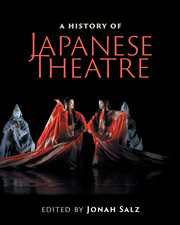Book contents
- Frontmatter
- Contents
- List of figures
- List of tables
- Contributors
- Contributors’ biographies
- Foreword
- Acknowledgments
- Note on Japanese terms
- List of abbreviations
- Timeline
- Editor's introduction
- I Traditional theatres
- Preface to Part I Japanese civilization arises
- II Modern theatres
- Preface to Part II
- III Arcs and patterns
- 12 Premodern playwriting practices
- 13 Traditional meta-patterns
- 14 Modern plays as literature
- 15 Modern meta-patterns
- Interlude Dōjōji: The lady and the bell
- IV Theatre architecture
- Preface to Part IV Evolution of Japanese theatre architecture
- V Theatre criticism
- VI Intercultural influences
- Epilogue: Frozen words and mythology
- Further reading
- Index
15 - Modern meta-patterns
from III - Arcs and patterns
Published online by Cambridge University Press: 05 July 2016
- Frontmatter
- Contents
- List of figures
- List of tables
- Contributors
- Contributors’ biographies
- Foreword
- Acknowledgments
- Note on Japanese terms
- List of abbreviations
- Timeline
- Editor's introduction
- I Traditional theatres
- Preface to Part I Japanese civilization arises
- II Modern theatres
- Preface to Part II
- III Arcs and patterns
- 12 Premodern playwriting practices
- 13 Traditional meta-patterns
- 14 Modern plays as literature
- 15 Modern meta-patterns
- Interlude Dōjōji: The lady and the bell
- IV Theatre architecture
- Preface to Part IV Evolution of Japanese theatre architecture
- V Theatre criticism
- VI Intercultural influences
- Epilogue: Frozen words and mythology
- Further reading
- Index
Summary
Stepping far enough away from Japanese theatre as a cultural phenomenon, three interrelated theatrical meta-patterns can be discerned: the Realistic, the Quiet, and the Frenetic. The modern Realistic meta-pattern descended from premodern sewamono (plays of everyday life best found in shingeki realism). Quietude refers to minimalist dramaturgy drawn from Zen aesthetics and its manifestation in noh – silence, stillness, and fluidity of time-space. Two kinds of theatrical quietude are evident today: one is inspired by and adapts aspects of noh: the second is based on more modern conceptualizations of subjectivity. Frenetic dramaturgy employs an extroverted theatricality descended from kabuki in its use of multiple plotlines, heightened acting, elaborate costumes, and special effects.
These three meta-patterns enable us to view theatrical phenomena broadly, borderlessly, and in a transhistorical perspective. The modern period has seen two major meta-pattern shifts in theatre: the Realistic mode developed and matured into realism in the first half of the twentieth century while the Frenetic enjoyed a magnificent resurgence in the 1960s. Quietude has resurfaced periodically – in the 1920s, the late 1970s, and the 1990s. In twenty-first-century Japanese theatre, the Frenetic meta-pattern is dominant, but Quietude is also highly developed (see list of playwrights, Focus 11.1).
Modern Japanese playwrights usually write for their own theatre company and devise action and characterization to match their actors’ qualities. Since playwrights are frequently directors as well, their scripts may provide only basic dialogue and structure of plays, assuming much may develop during rehearsals. A playwright, as the English suffix “wright” better suggests, crafts a play; discussion here goes beyond the play as a piece of finished writing to attend to dramaturgy and staging as well.
The Realistic meta-pattern
Focused on social interactions, the Realistic meta-pattern is dialogue-centered and requires verisimilitude. Verisimilitude calls forth objective reality for the reader/viewer through factual accuracy, naturalistic characterization, life-sized (tōshindai) action, and most importantly a sense of plausibility. Various iterations include melodramatic and comic, as well as serious dramas.
Several kinds of realistic drama flourished during Japan's attempt to move away from premodern kabuki. These included katsureki living-history kabuki plays, melodramatic shimpa, and Sawada Shōjirō's shinkokugeki, a genre of patriotic swordfighting plays. Shingeki realism surpassed other experimental forms in creating a fully constructed sense of reality that precluded the sensational and supernatural.
- Type
- Chapter
- Information
- A History of Japanese Theatre , pp. 397 - 410Publisher: Cambridge University PressPrint publication year: 2016



